Four Ways To Find Power:
**Compression
Bore
Stroke
All of the aboveBolting on performance parts comes at the cost of the parts, some elbow grease and typically the difficulty in instantly feeling what improvements have been made. Most of the time you don't have the chance to go back-to-back, one change at a time. Sometimes it is hard to just decide what you want to do to your machine in the first place. The stock bikes are so good these days, it is often easier to mess them up than make them better. Unless you're careful!Dirt Rider turned to Jay Clark, the Mayor of Modificationville, but we gave him a strict plan. We wanted to see exactly what individual components inside an engine do to the performance by isolating them in four identically prepped bikes to see where they shined and if there are any disadvantages to different setups. With the help of Brad Meizener of Parapros (www.parapros.com), we were sitting on four fresh-yet-different 2008 CRF250Rs: a 14.5:1-high-compression-piston-only #101; a built-up 14.5:1-compression and 1mm-overbore #102; a 1.5mm-stroker-crank, lower-compression 13.5:1-stock-bore-piston #103; and finally the 1mm-bore-and-1.5mm-stroke, 13.5:1-compression #104. All the bikes had Hot Cams' Stage 2 Gold Series cam installed, as Jay feels these work as a kit with the setups he builds. We chose a 50/50 blend of Texaco Super mixed with VP U4.2 race gas to get the most out of the modifications; high compression likes a little race gas. All of the bikes were prepped with identical MB1 suspension and fresh Dunlop D756 tires. We also sampled the quartet with the stock exhaust and with FMF's 4.1 MegaBomb Ti system. We found the aftermarket system enhanced the performance of the 101, 102 and 103 bikes, but not the 104. Another good thing about this story is that the results are consistent with our experience in similar modifications on other brands of 250Fs. Plus, these very same mods will work on almost all years of Honda CRF250Rs. Enjoy!Bike #101:
stock bore/displacement, 14.5:1 high-compression
This is a simple bolt-in modification, and it was clearly more lively than the stock bike. It acts a lot crisper and is more responsive to the twists of the throttle and was considered a great first-step modification by all of our test riders. Powerwise it seems to make just a little bit more power everywhere and retains the stock style of spread, which means quick revving and meaty power up on top. The biggest downside was that the starting was harder than stock, which can be attributed to the exhaust cam timing and the automatic decompression device not being as effective.Bike #102:
+1mm bore, 14.5:1 high-compression
Can just 1mm of bore really make a difference? The answer is yes, and it was pretty impressive actually. At 256cc, there was a noticeable increase in power and pull without the bike getting lazy or sluggish to rev at all. It was just as crisp and snappy as the stock bore, but it seemed to pull better with more power everywhere. And of all the bikes, this was our favorite setup for racing motocross even if it was cheating! Especially for high-level riders who are able to keep the bike revving and pulling on the top, it was the best pulling and fastest bike. The small addition in bore was similar to performance gains we've experienced by doing a lot of more costly modifications to the valve train while keeping the standard bore. As with all the bikes, the starting was a little more difficult.Web Addresses:
**www.hotcamsinc.com, www.cppistons.com, www.cometic.com,www.cylinder-works.com, www.mt-llc.com, www.fmfracing.com, www.paraprosracing.com, www.hotrodsproducts.com
Bike #103:
**+1.5mm stroker, 13.5:1 high-compression
This was the most finicky of the bikes and took the most jetting and setup work to come to the finished 257cc machine. It was slower revving than the nonstroked bikes and it made a slightly more torquey pull, but not a big difference in outright power, actually feeling a bit off on top. If you're the kind of rider who likes to let the motor do the work by using the throttle and not the clutch, then this is a step in the right direction. Truthfully, all of our test riders would opt to go one step more (see bike 104) if we were going into the cases to replace the crank. There was also more vibration and harder starting than stock.Bike #104:
**+1mm bore and +1.5mm stroker, 13.5:1 high-compression
This 263cc creation was by far the strongest feeling bike, but it did not seem like it was the fastest for pro riders since it didn't rev quick enough. What it did do was give the (formerly) 250F more torque and grunt, especially at lower rpm, and the meat to pull out of the turns without the need for clutching. If you like to chug a bike but don't want the weight of a 450, then a stroked and overbored 250F is an option. This bike's power was the best on the bottom and in the mid, and even though it seemed to rev out pretty respectably for a bored and stroked bike, that wasn't where this baby liked to be ridden. This bike also wanted to lose at least a tooth on the rear sprocket to get the most out of the newfound bottom pull. And for some reason the FMF exhaust system did not help this setup. There was a little more vibration, but not as much as the 103 bike. Starting was difficult as well.
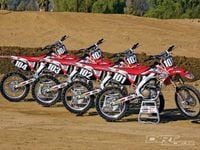
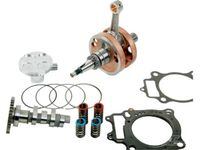
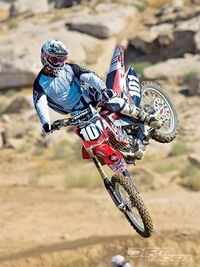
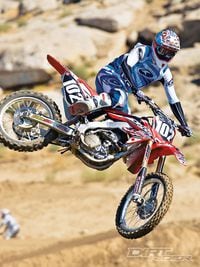
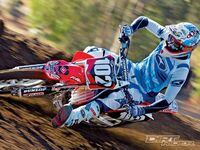
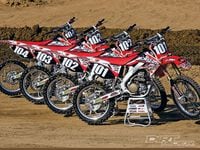
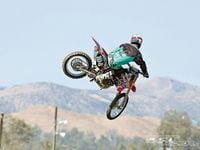
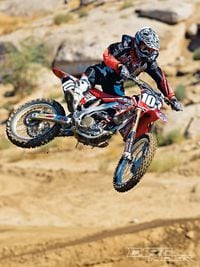
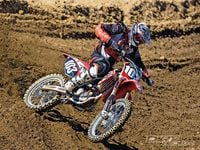
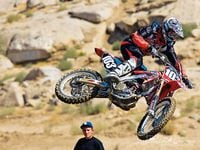
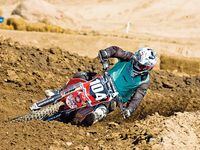
/cloudfront-us-east-1.images.arcpublishing.com/octane/BS47HZ5OA5CY3AXH45XE3W6U4Q.jpg)
/cloudfront-us-east-1.images.arcpublishing.com/octane/GSXINOVJ3FAKLG6W64QEZZPEMA.jpg)
/cloudfront-us-east-1.images.arcpublishing.com/octane/K4T5S3Y2WVGXZC3K2RHLPZ464U.jpg)
/cloudfront-us-east-1.images.arcpublishing.com/octane/V73POOGLKNBAHBKPZNZ4D275W4.jpg)
/cloudfront-us-east-1.images.arcpublishing.com/octane/7DV7UIBU5JABVOAPAKEKSREGBA.jpg)
/cloudfront-us-east-1.images.arcpublishing.com/octane/S634O4RKRRHWHIRX5ZEDVV2HJY.jpg)
/cloudfront-us-east-1.images.arcpublishing.com/octane/TI3FVHFEHVDMFKIWWA3GZIFASE.jpg)
/cloudfront-us-east-1.images.arcpublishing.com/octane/RWZDIX67AJG3BEE4OULV2DXKXA.jpg)
/cloudfront-us-east-1.images.arcpublishing.com/octane/DF7G3Y7H6FBJRDLHR2ISRMHKEU.jpg)
/cloudfront-us-east-1.images.arcpublishing.com/octane/3ETQKXY6V5E3BPT5AGNXOVMJWQ.jpg)
/cloudfront-us-east-1.images.arcpublishing.com/octane/VUHKDAOKNVH5VPC3QZHX2CKKRE.jpg)
/cloudfront-us-east-1.images.arcpublishing.com/octane/MIMXIJGIJNHOJPJCNBNYK754HE.jpg)
/cloudfront-us-east-1.images.arcpublishing.com/octane/7EUGVL7GEJBTFGMNOEYQKRUCBM.jpg)

/cloudfront-us-east-1.images.arcpublishing.com/octane/BG3IQBQQZNEJ5LPR4SL457WJDA.jpg)
/cloudfront-us-east-1.images.arcpublishing.com/octane/4ZVOBB7ZAFAQ7PGF4WIFD2SB5U.jpg)
/cloudfront-us-east-1.images.arcpublishing.com/octane/GVALYAEPCZCWHLVPSQBEKF54XQ.jpg)
/cloudfront-us-east-1.images.arcpublishing.com/octane/2JIELXVLZJCSXIINID53DIC45Y.jpg)
/cloudfront-us-east-1.images.arcpublishing.com/octane/FSYXC6UZDVCORAGEB3WPO7WTI4.jpg)
/cloudfront-us-east-1.images.arcpublishing.com/octane/4PLHXJPL5ZFTFN5F4RA3S7UZ6I.jpg)

/cloudfront-us-east-1.images.arcpublishing.com/octane/656MRIMBP5DYLN2WZHAE4HHBHU.jpg)
/cloudfront-us-east-1.images.arcpublishing.com/octane/V3VDJRGW2VF3BCU36I4CA7MHQE.jpg)
/cloudfront-us-east-1.images.arcpublishing.com/octane/EKDLFEU34ZEPTMZXIZHYTZNLV4.jpg)